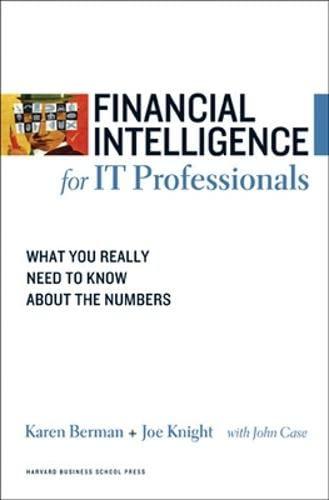Answered step by step
Verified Expert Solution
Question
1 Approved Answer
REQUIRED: Please show all your workings clearly, and in a coherent manner. MARKS You are expected to number your answers accordingly. 1.1. Under each expected


REQUIRED: Please show all your workings clearly, and in a coherent manner. MARKS You are expected to number your answers accordingly. 1.1. Under each expected monthly demand level, calculate: i. ii. Degree of Operating Leverage Degree of Financial Leverage Degree of Combined Leverage iii. 1.2. With the help of your answers in (1.1.), and given the respective Industry norms or benchmarks: As a procurement officer, would you recommend your entity to procure the face-masks from KM? Why or why not? 25 (NB: In order to answer this question appropriately, first tell us what does each of the three Business Risk indicators measure. Also, for all your calculations, please be detailed as much as possible - clearly showing us how each figure has been obtained/arrived at. This is likely to increase your probability to score good marks in this assignment). 1.3. Under each expected monthly demand level, calculate the expected monthly face-masks that should be produced in order for KM to break-even. TOTAL MARKS FOR QUESTION 1 25 QUESTION 2 (15 MARKS) Suppose you have been tasked to appraise the following two mutually exclusive projects. Given your entity's financial constraints, your entity opts to evaluate all its intended capital projects on the basis of Net Present Value (NPV), and Profitability Index (PI). A 12% cost of capital is applicable. NB: All the expected future cash inflows have appropriately been adjusted for depreciation. PROJECT A Period 1 2 3 4 5 0 250,000.00 Initial investment 75,000.00 78,000.00 85,000.00 68,000.00 Expected future cash inflows 80,000.00 PROJECT B Period 0 1 4 2 3 5 Initial investment (NS) 250,000.00 Expected future cash inflows (NS) 90,000.00 110,000.00 92,000.00 100,000.00 110,000.00 It is the entity's policy to only accept projects with a maximum pay-back-period (PBP) of two years. Similar projects usually take a minimum of three years before the initial investment is recovered. MARKS Project cannot be undertelen REQUIRED: NB: For qualitative questions, please gooid any cut and paste from the slides as that would land you into a 0% grading. 2-5 2.1. Distinguish between a Divisible and Non-divisible project. Give an example as a way of supporting your answer. 2.5 2.2. In what way are Mutually exclusive projects differ from Independent projects 6 2.3. On the basis of (i) NPV and (ii) PI, which project should be undertaken by your entity? On the basis of PBP, which project would you recommend? 3 2.4. 1 2.5. Given your answers in (2.3.) to (2.4.), are there any conflicting recommendations? TOTAL MARKS FOR QUESTION 2 15 When a Project can be undtala a parts //END// Some mot prople only one / cut sheld be acceed at ame) project Profili REQUIRED: Please show all your workings clearly, and in a coherent manner. MARKS You are expected to number your answers accordingly. 1.1. Under each expected monthly demand level, calculate: i. ii. Degree of Operating Leverage Degree of Financial Leverage Degree of Combined Leverage iii. 1.2. With the help of your answers in (1.1.), and given the respective Industry norms or benchmarks: As a procurement officer, would you recommend your entity to procure the face-masks from KM? Why or why not? 25 (NB: In order to answer this question appropriately, first tell us what does each of the three Business Risk indicators measure. Also, for all your calculations, please be detailed as much as possible - clearly showing us how each figure has been obtained/arrived at. This is likely to increase your probability to score good marks in this assignment). 1.3. Under each expected monthly demand level, calculate the expected monthly face-masks that should be produced in order for KM to break-even. TOTAL MARKS FOR QUESTION 1 25 QUESTION 2 (15 MARKS) Suppose you have been tasked to appraise the following two mutually exclusive projects. Given your entity's financial constraints, your entity opts to evaluate all its intended capital projects on the basis of Net Present Value (NPV), and Profitability Index (PI). A 12% cost of capital is applicable. NB: All the expected future cash inflows have appropriately been adjusted for depreciation. PROJECT A Period 1 2 3 4 5 0 250,000.00 Initial investment 75,000.00 78,000.00 85,000.00 68,000.00 Expected future cash inflows 80,000.00 PROJECT B Period 0 1 4 2 3 5 Initial investment (NS) 250,000.00 Expected future cash inflows (NS) 90,000.00 110,000.00 92,000.00 100,000.00 110,000.00 It is the entity's policy to only accept projects with a maximum pay-back-period (PBP) of two years. Similar projects usually take a minimum of three years before the initial investment is recovered. MARKS Project cannot be undertelen REQUIRED: NB: For qualitative questions, please gooid any cut and paste from the slides as that would land you into a 0% grading. 2-5 2.1. Distinguish between a Divisible and Non-divisible project. Give an example as a way of supporting your answer. 2.5 2.2. In what way are Mutually exclusive projects differ from Independent projects 6 2.3. On the basis of (i) NPV and (ii) PI, which project should be undertaken by your entity? On the basis of PBP, which project would you recommend? 3 2.4. 1 2.5. Given your answers in (2.3.) to (2.4.), are there any conflicting recommendations? TOTAL MARKS FOR QUESTION 2 15 When a Project can be undtala a parts //END// Some mot prople only one / cut sheld be acceed at ame) project Profili
Step by Step Solution
There are 3 Steps involved in it
Step: 1

Get Instant Access to Expert-Tailored Solutions
See step-by-step solutions with expert insights and AI powered tools for academic success
Step: 2

Step: 3

Ace Your Homework with AI
Get the answers you need in no time with our AI-driven, step-by-step assistance
Get Started


